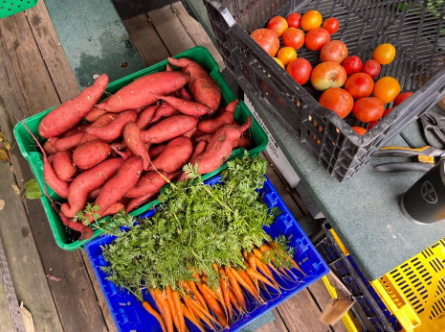What's Growing in the Garden - November 2022
by Zac Hoppenstedt
Content for this gardening recap comes firsthand from observation and experience of K-State Extension agents and volunteers who oversee the WIC Community Garden, the ¼ acre urban farm space focused on fruit and vegetable production located at the Johnson County Extension office. The WIC Garden is one part trial and teaching grounds for urban agriculture and one part community resource for food access and fresh produce donation to those in need. Read more about the garden and volunteer opportunities at: https://www.johnson.k-state.edu/lawn-garden/wic-community-garden/index.html
With our first frost in the books and the holidays fast approaching, the winter season is upon us. At the WIC garden, we are wrapping up a productive growing season and transitioning to the fallow period with a few final tasks. Namely we’re focused on winterizing, i.e. getting spent plant residues out of the field, covering beds and making sure that overwintering plants like strawberries are protected. And we’re planting lots of garlic for harvest next year. We have so much organic material to manage this time of year and thus winter maintenance of our community composting system is crucial. Lastly, the window for cover crops is really coming to a close so if you haven’t gotten yours in yet, be sure to do so in the coming days to allow enough time for germination/establishment. To learn more, read on for this month’s edition of “What’s Growing in the Garden”.
Winterizing the Garden
Fall is a great time to tidy up the garden space. Remove senesced plants, take down trellis stakes and weed the beds one last time before the overwhelming cold of winter and wetness of spring. We try to never leave soil in our growing beds completely bare going into the winter. We use a good amount of straw mulch and compost to prevent erosion, insulate the soil life and add some organic matter that we can incorporate next year. We use organic mulch on a lot of the beds during the growing season and we can reuse a good amount of what’s remaining on the bed but we usually try to reapply until we have a solid two inch cover.
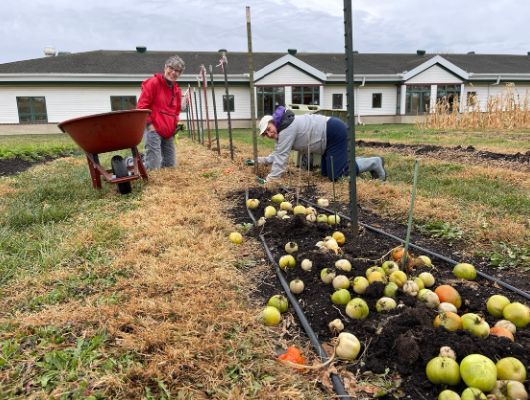
Strawberry Mulching
We have over 200 strawberry plants we’re overwintering in the garden this year. Right now we are just trying to do a final weeding of those beds but later this month between Thanksgiving and Christmas it’s recommended that you cover the plants with a thick straw mulch. Extreme cold can kill flower buds and consequently decrease your fruit production the following year. We shoot for close to three inches of cover for this specific type of mulching. When the plants starting pushing through with green growth in the spring you should uncover the plants but keep mulch around the base of the crown.
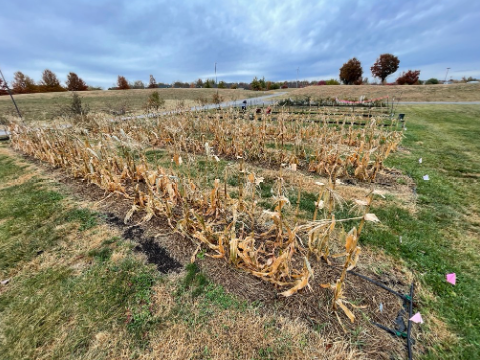
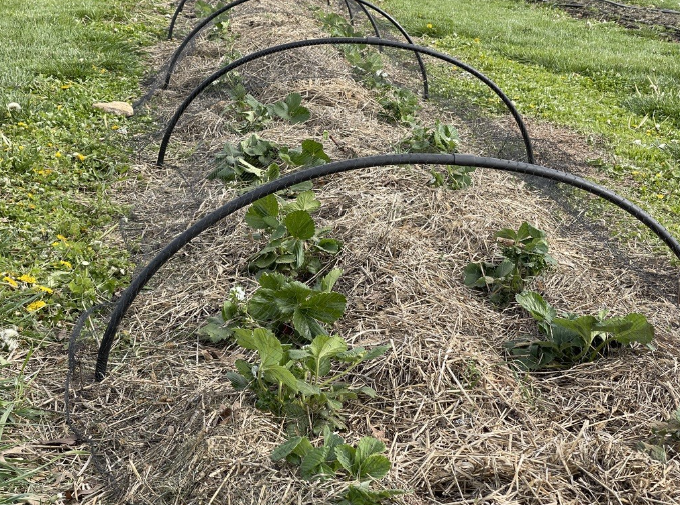
Garlic Planting
There is one vegetable crop we are still planting this time of year. Garlic is one of the simplest crops to grow in your garden with just a bit of preparation. Fall planting, generally from late September thru November provides necessary cold period and allows for early growth in spring to support new bulb development. Mature bulbs will be ready for harvest in late June of next year.
When selecting your seed, there are two main categories to choose from, Hardneck and Softneck. Softneck varieties have no central seedstalk, tops can be braided, usually stores longer, are less winter hardy, are not as flavorful. Hardneck varieties (better for later planting) have a solid central seedstalk, more uniform cloves, larger and easier to peel cloves, more variations in color, unique flavor differences, and are very winter hardy.
Seed will usually come as whole bulbs. Although it varies between varieties, one pound of garlic can plant 30 feet of row. Gently separate cloves (keeping the paper like outer layer intact). Select large garlic cloves that are uniform and firm. Plant cloves 2-3 inches deep into loose soil with the pointed end covered but going up. Space cloves 4-5 inches apart within each row and put 8-10 inches of space between rows.
Mulching with straw is not required but can promote better growing conditions. When you apply the mulch, sprinkle a little loose soil over the mulch and wet it down. This will prevent the loose mulch from blowing away. After a rain, the mulch will settle in around the plants and will remain in place through the rest of the winter.
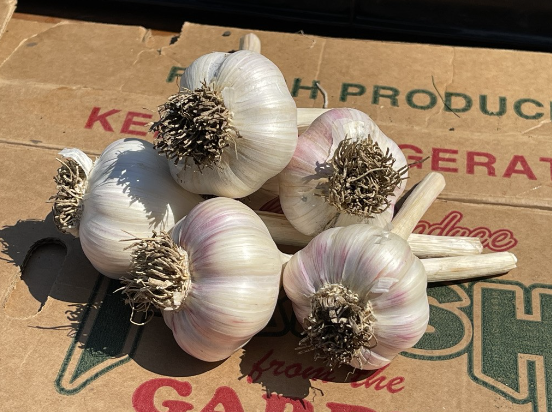
Managing Compost in Winter
We are flush with expired plants this time of year, mountains of dried tomatoes plants, sweetpotato vines, fallen leaves and more. Aside from markedly diseased plant residues, we compost all of our organic waste at the garden. Because we also accept kitchen scraps from our volunteers throughout the year. We dry and store the garden residues separately so that donation of fresh kitchen waste (i.e. green material aka the nitrogen source) can always be mixed with 2 times the amount of dried carbon rich material (browns) like shredded leaves, wood chips, straw and dried veg stalks. We keep the compost piles full and regularly watered even during the winter. The decomposition moves slower this time of year but with active management it can still get quite hot during the winter.
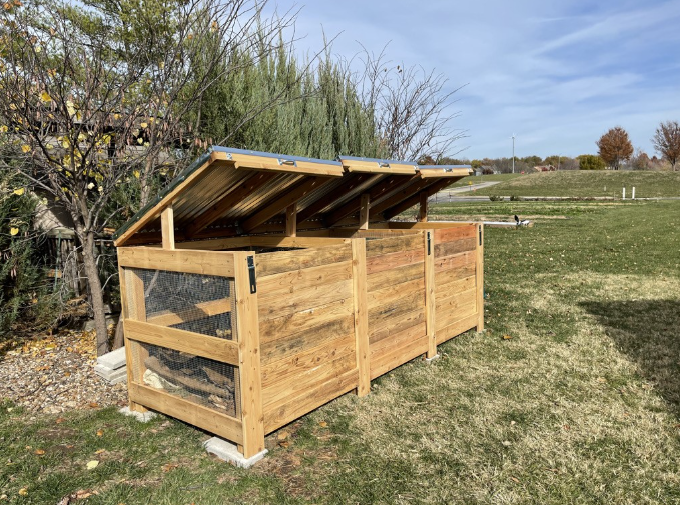
Last Call for Cover Crops
Besides mulch, we also like to keep beds covered by establishing cover crops (i.e. living ground covers of grain, legumes and brassicas). Despite the unseasonably warm weather forecasted at the time of writing, most cover crops seeded at this late stage either won’t germinate or will be frost killed before they can contribute much cover to the growing beds. We will continue seeding cereal/winter rye and winter wheat for a few more weeks thru mid-November. Like mulching, growing cover crops protects the soil but living plants on the garden beds is even more valuable because of the contributions that living roots provide soil organisms.
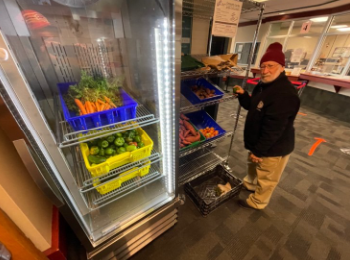
Last Workdays
This first week of November marks the end of the 2022 weekly volunteer workdays. Check our website for special meetups and activities that we’ll schedule throughout the winter. Weekly volunteer days will start up again in March 2023. We are so grateful for the many contributions of our volunteers and all the community support this year. The garden program produced over 3,500 pound of produce for donation across Johnson County and at the newly formed pantry located at the Health Department lobby in Olathe. We’ll be doing our best to supply produce to the pantry as long as we can thru the winter.
